Cast crowns on teeth
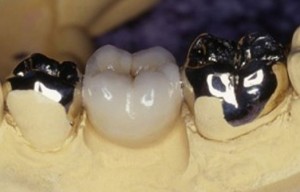
Cast crowns for teeth - These are cast constructions.
Such crowns are made of metal and alloys. The entire crown is cast in its entirety.
With bridge prosthetics, the possibility of soldering adjacent crowns is excluded.
Cast crowns are now used with great success in prosthetics of the chewing group of teeth, as well as in the manufacture of telescopic crowns.
It is advisable to install them with increased tooth abrasion.
Also, in order to reduce the cost of prosthetics, it is possible to combine cast metal structures with cermets.
Kinds
Cast crowns can be presented in the following options:
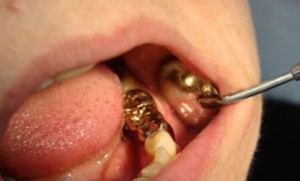
- Cast metal crown without spraying. This is a common construction that looks like polished metal.
- Gold-plated metal crown. It should be noted that sprayed structures can have a negative effect on the oral mucosa.
- Cast crown with facing. The front surface of the metal structure is coated with plastic or ceramic. This is a more attractive design option for the patient, which imposes certain requirements on aesthetics. Sometimes chipping may appear on the cladding. The cost of a cast crown lined with ceramics on one side is lower than a cermet structure coated with ceramics on all sides.
- The combined bridge is a structure where cast crowns and cermet are present.
Features
Cast constructions have a number of features:
- The crown is made according to an individual impression.
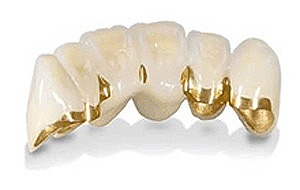
Photo: Cermet cast bridge - Excellent fit to the tooth surface.
- The presence of an anatomical shape, which eliminates the ingestion of particles of food and saliva under the design.
- The absence of the need for a strong turning of the tooth, which extends its service life.
- More simple to manufacture than cermets or metal-free ceramics.
- High strength and durability of the structure.
- The absence of adhesions in the manufacture of the prosthesis, which gives the strength of the structure and ensures its safety for the patient's oral cavity.
- The longevity of the dental crown associated with high quality workmanship.
- Relatively low cost.
The disadvantage of cast crowns is that they are unaesthetic and can cause an allergic reaction to the metal and alloys that make up their composition.
Advantages of cast constructions over stamped ones:
- The presence of a more rigid frame, which contributes to a more reliable fastening of facing materials.
- A more precise fit of the structure to the tooth stump ensures a secure fixation.
- Cast combined crowns represent a rather convenient design for supporting the bridge.
- The life of cast crowns is longer than stamped.
Cast gold crowns
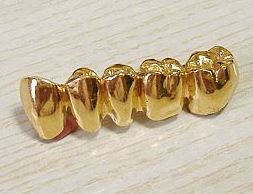
Gold designs deserve special attention.
Gold has a beneficial effect on the body, has excellent biocompatibility with tooth tissues, so that there is no allergy to gold.
The hardness of the metal is close to the dental tissue, as a result of which there is no abrasion of antagonist teeth.
The ductility and softness of the metal make it possible to achieve a perfect fit of the structure to the tooth and nullify the formation of cracks and damage to the crown.
Cermet crown
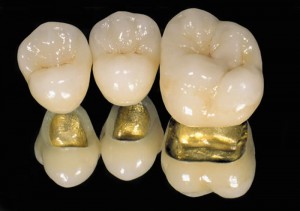
The design consists of a cast metal frame and a coating of ceramic mass. Cast base gives strength to the crown, and ceramic coating - a natural look.
Cermet crowns are ideal for prosthetics of both the anterior and chewing teeth.
Titanium, cobalt-chromium alloy, gold, palladium, platinum are used to manufacture the frame of the ceramic-metal construction.
The presence of a sufficient choice of metal for and ceramic masses allows you to choose the best option for dental prosthetics.
Among the disadvantages of cermets is the possibility of an allergy to metal.